Dynamics of Volunteering and Life Satisfaction in Midlife and Old Age: Findings from 12 European Countries
Abstract
:1. Introduction
2. Materials and Methods
2.1. Data
2.2. Dependent and Independent Variables
2.3. Control Variables
3. Results
4. Discussion
5. Conclusions
Author Contributions
Acknowledgments
Conflicts of Interest
References
- Anderson, Nicole D., Thecla Damianakis, Edeltraut Kröger, Laura M. Wagner, Deirdre R. Dawson, Malcolm A. Binns, Syrelle Bernstein, Eilon Caspi, and Suzanne L. Cook. 2014. The benefits associated with volunteering among seniors: A critical review and recommendations for future research. Psychological Bulletin 140: 1505–33. [Google Scholar] [CrossRef] [PubMed]
- Binder, Martin, and Andreas Freytag. 2013. Volunteering, subjective well-being and public policy. Journal of Economic Psychology 34: 97–119. [Google Scholar] [CrossRef]
- Börsch-Supan, Axel. 2017. Survey of Health, Ageing and Retirement in Europe (SHARE) Wave 1. Release version: 5.0.0. SHARE-ERIC Data Set. [Google Scholar] [CrossRef]
- Börsch-Supan, Axel, Martina Brandt, Christian Hunkler, Thorsten Kneip, Julie Korbmacher, Frederic Malter, Barbara Schaan, Stephanie Stuck, and Sabrina Zuber. 2013. Data resource profile: The Survey of Health, Ageing and Retirement in Europe (SHARE). International Journal of Epidemiology 42: 992–1001. [Google Scholar] [CrossRef] [PubMed]
- Casiday, Rachel, Eileen Kinsman, Clare Fisher, and Clare Bambra. 2008. Volunteering and Health; What Impact Does It Really Have. London: Volunteering England. [Google Scholar]
- CEV. 2012. Volunteering Infrastructure in Europe. Brussels: European Volunteer Centre. [Google Scholar]
- Erlinghagen, Marcel, and Karsten Hank. 2006. The participation of older Europeans in volunteer work. Ageing & Society 26: 567–84. [Google Scholar]
- EVS. 2016. European Values Study 2008: Integrated Dataset (EVS 2008). GESIS Data Archive, Cologne. ZA4800 Data file Version 4.0.0. Mannheim: GESIS. [Google Scholar] [CrossRef]
- Fischer, Lucy Rose, and Kay Banister Schaffer. 1993. Older Volunteers: A Guide to Research and Practice. Thousand Oaks: Sage Publications, Inc. [Google Scholar]
- Hank, Karsten, and Stephanie Stuck. 2008. Volunteer work, informal help, and care among the 50+ in Europe. Social Science Research 37: 1280–91. [Google Scholar] [CrossRef] [PubMed]
- Haski-Leventhal, Debbie. 2009. Elderly volunteering and well-being: A cross-European comparison based on SHARE data. Voluntas: International Journal of Voluntary and Nonprofit Organizations 20: 388–404. [Google Scholar] [CrossRef]
- Jenkinson, Caroline E., Andy P. Dickens, Kerry Jones, Jo Thompson-Coon, Rod S. Taylor, Morwenna Rogers, Clare L. Bambra, Iain Lang, and Suzanne H. Richards. 2013. Is volunteering a public health intervention? A systematic review and meta-analysis of the health and survival of volunteers. BMC Public Health 13: 773–84. [Google Scholar] [CrossRef] [PubMed]
- Kim, Joongbaeck, and Manacy Pai. 2010. Volunteering and Trajectories of Depression. Journal of Aging and Health 22: 84–105. [Google Scholar] [CrossRef] [PubMed]
- Lee, Young-joo, and Jeffrey L. Brudney. 2012. Participation in formal and informal volunteering: Implications for volunteer recruitment. Nonprofit Management and Leadership 23: 159–80. [Google Scholar] [CrossRef]
- Li, Yunqing, and Kenneth F. Ferraro. 2005. Volunteering and depression in later life: Social benefit or selection processes? Journal of Health and Social Behavior 46: 68–84. [Google Scholar] [CrossRef] [PubMed]
- Li, Yunqing, and Kenneth F. Ferraro. 2006. Volunteering in middle and later life: Is health a benefit, barrier or both? Social Forces 85: 497–519. [Google Scholar] [CrossRef]
- McMunn, Anne, James Nazroo, Morten Wahrendorf, Elizabeth Breeze, and Paola Zaninotto. 2009. Participation in socially-productive activities, reciprocity and wellbeing in later life: Baseline results in England. Ageing and Society 29: 765–82. [Google Scholar] [CrossRef]
- Meier, Stephan, and Alois Stutzer. 2008. Is volunteering rewarding in itself? Economica 75: 39–59. [Google Scholar] [CrossRef]
- Mellor, David, Yoko Hayashi, Mark Stokes, Lucy Firth, Lucy Lake, Michael Staples, Sue Chambers, and Robert Cummins. 2009. Volunteering and its relationship with personal and neighborhood well-being. Nonprofit Voluntary Sector Quarterly 38: 144–59. [Google Scholar] [CrossRef]
- Menec, Verena H. 2003. The relation between everyday activities and successful aging: A 6-year longitudinal study. The Journals of Gerontology Series B: Psychological Sciences and Social Sciences 58: S74–82. [Google Scholar] [CrossRef]
- Morrow-Howell, Nancy, Susan Kinnevy, and Marylen Mann. 1999. The perceived benefits of participating in volunteer and educational activities. Journal of Gerontology and Social Work 32: 65–80. [Google Scholar] [CrossRef]
- Musick, Marc A., and John Wilson. 2003. Volunteering and depression: The role of psychological and social resources in different age groups. Social Science & Medicine 56: 259–69. [Google Scholar] [CrossRef]
- OECD. 2016. Society at a Glance. OECD Social Indicators. Paris: OECD Publishing. [Google Scholar] [CrossRef]
- Piliavin, Jane Allyn, and Erica Siegl. 2007. Health benefits of volunteering in the Wisconsin longitudinal study. Journal of Health and Social Behavior 48: 450–64. [Google Scholar] [CrossRef] [PubMed]
- Pilkington, Pamela D., Tim D. Windsor, and Dimity A. Crisp. 2012. Volunteering and subjective well-being in midlife and older adults: The role of supportive social networks. Journals of Gerontology Series B: Psychological Sciences and Social Sciences 67: 249–60. [Google Scholar] [CrossRef] [PubMed]
- Prince, Martin J., Friedel Reischies, A. T. Beekman, Rebecca Fuhrer, Catholijn Jonker, Sirkka-Liisa Kivela, Brian A. Lawlor, Antonio Lobo, H. Magnusson, and M. Fichter. 1999. Development of the EURO-D scale—A European Union initiative to compare symptoms of depression in 14 European centres. The British Journal of Psychiatry 174: 330–38. [Google Scholar] [CrossRef] [PubMed]
- Principi, Andrea, Per H. Jensen, and Giovanni Lamura, eds. 2014. Active Ageing: Voluntary Work by Older People in Europe. Bristol: Policy Press. [Google Scholar]
- Radloff, Lenore Sawyer. 1977. The CES-D scale: A self-report depression scale for research in the general population. Applied Psychological Measurements 1: 385–401. [Google Scholar] [CrossRef]
- Ryan, Richard M., and Edward L. Deci. 2001. On happiness and human potentials: A review of research on hedonic and eudaimonic well-being. Annual Review of Psychology 52: 141–66. [Google Scholar] [CrossRef] [PubMed]
- Schwingel, Andiara, Mathew M. Niti, Catherine Tang, and Tze Pin Ng. 2009. Continued work employment and volunteerism and mental well-being of older adults: Singapore longitudinal ageing studies. Age & Ageing 38: 531–37. [Google Scholar]
- Seligman, Martin E.P. 2002. Authentic Happiness: Using the New Positive Psychology to Realize Your Potential for Lasting Fulfillment. New York: Free Press. [Google Scholar]
- Shmotkin, Dov, Tzvia Blumstein, and Baruch Modan. 2003. Beyond keeping active: Concomitants of being a volunteer in old-old age. Psychology and Aging 18: 602–7. [Google Scholar] [CrossRef] [PubMed]
- Slagsvold, Britt, Marijke Veenstra, Svein Olav Daatland, Gunhild Hagestad, Thomas Hansen, Katharina Herlofson, Kristine Koløen, and Per Erik Solem. 2012. Life-course, ageing and generations in Norway: The NorLAG study. Norsk Epidemiologi 22: 95–102. [Google Scholar] [CrossRef]
- Son, Joonmo, and John Wilson. 2012. Volunteer Work and Hedonic, Eudemonic, and Social Well-Being. Sociological Forum 27: 658–81. [Google Scholar] [CrossRef]
- Strom, Robert D., and Shirley K. Strom. 1995. Intergenerational learning: Grandparents in the schools. Educational Gerontology: An International Quarterly 21: 321–35. [Google Scholar] [CrossRef]
- Thoits, Peggy A., and Lyndi N. Hewitt. 2001. Volunteer work and well-being. Journal of Health and Social Behavior 42: 115–31. [Google Scholar] [CrossRef] [PubMed]
- Van Willigen, Marieke. 2000. Differential benefits of volunteering across the life course. The Journals of Gerontology Series B: Psychological Sciences and Social Sciences 55: S308–18. [Google Scholar] [CrossRef]
- Von Bonsdorff, Mikaela B., and Taina Rantanen. 2011. Benefits of formal voluntary work among older people. A review. Aging Clinical and Experimental Research 23: 162–69. [Google Scholar] [CrossRef] [PubMed]
- Walker, Alan, and Tony Maltby. 2012. Active ageing: A strategic policy solution to demographic ageing. International Journal of Social Welfare 21: 117–30. [Google Scholar] [CrossRef]
- WHO. 2002. Active Ageing: A Policy Framework 2002. Geneva: WHO. [Google Scholar]
- Wilson, John, and Marc Musick. 1997. Who cares? Toward an integrated theory of volunteer work. American Sociological Review 5: 694–713. [Google Scholar] [CrossRef]
- Wilson, John, and Marc Musick. 1999. The effects of volunteering on the volunteer. Law and Contemporary Problems 62: 141–68. [Google Scholar] [CrossRef]
- Windsor, Timothy D., Kaarin J. Anstey, and Bryan Rodgers. 2008. Volunteering and psychological well-being among young-old adults: How much is too much? Gerontologist 48: 59–70. [Google Scholar] [CrossRef] [PubMed]
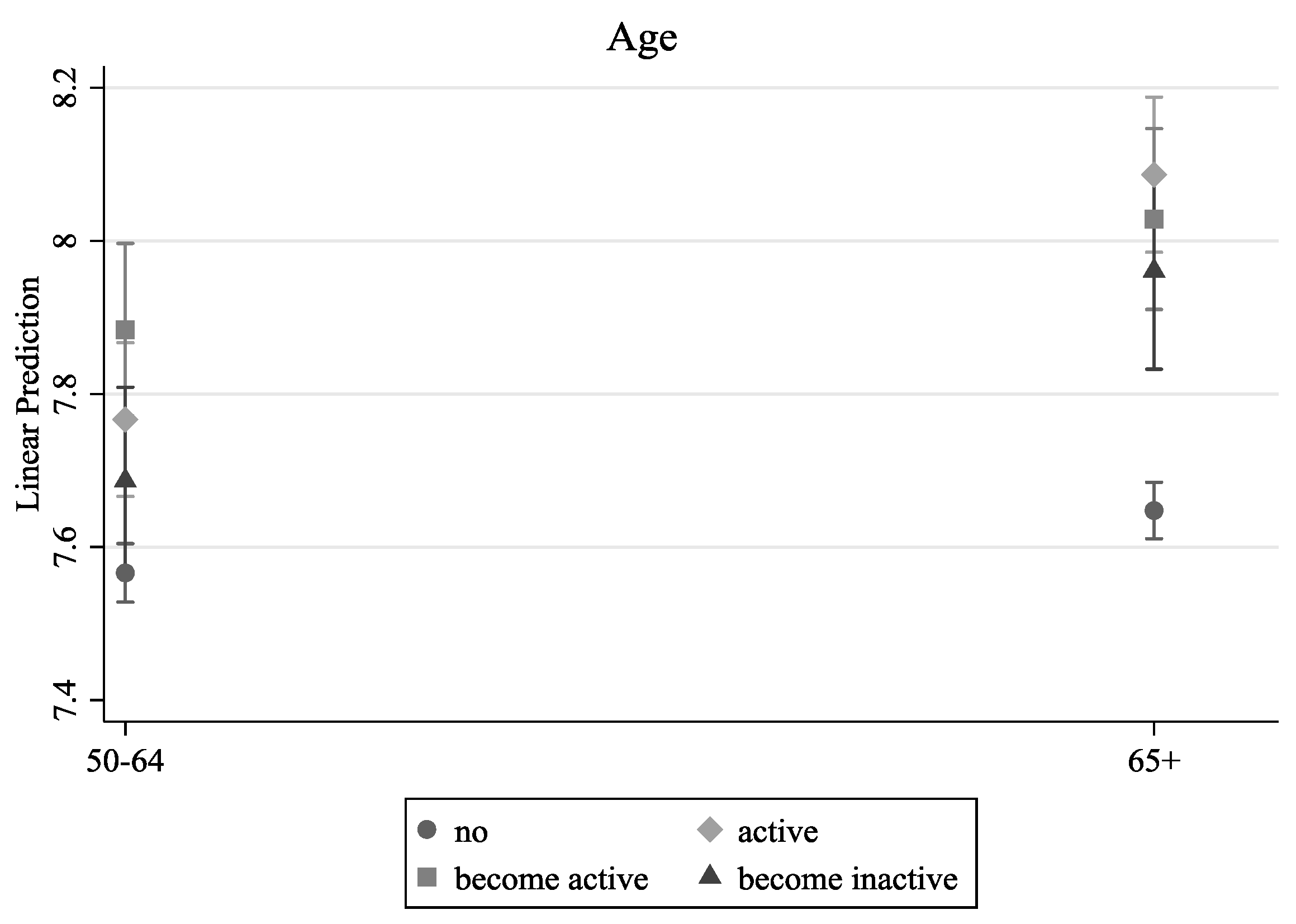
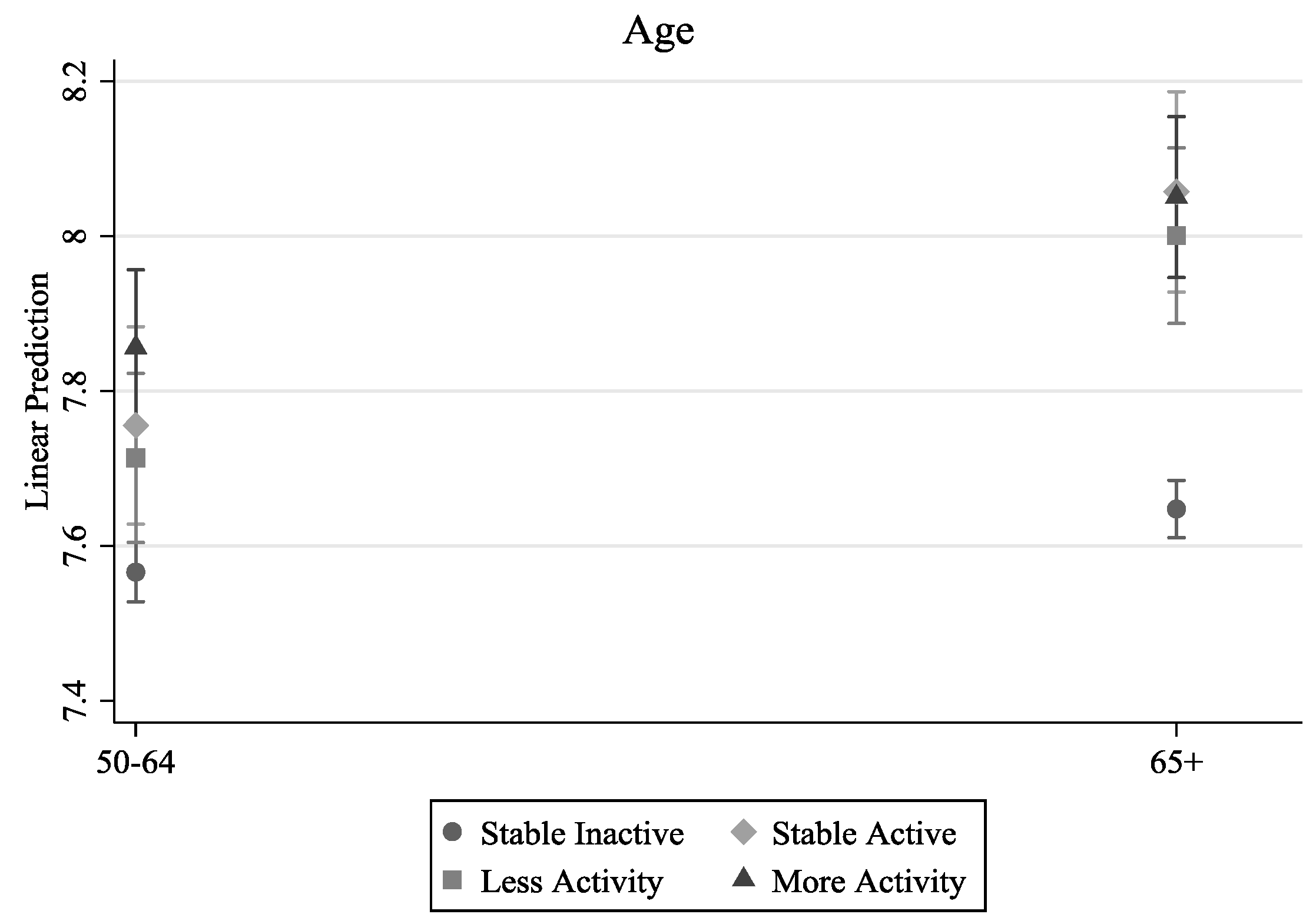
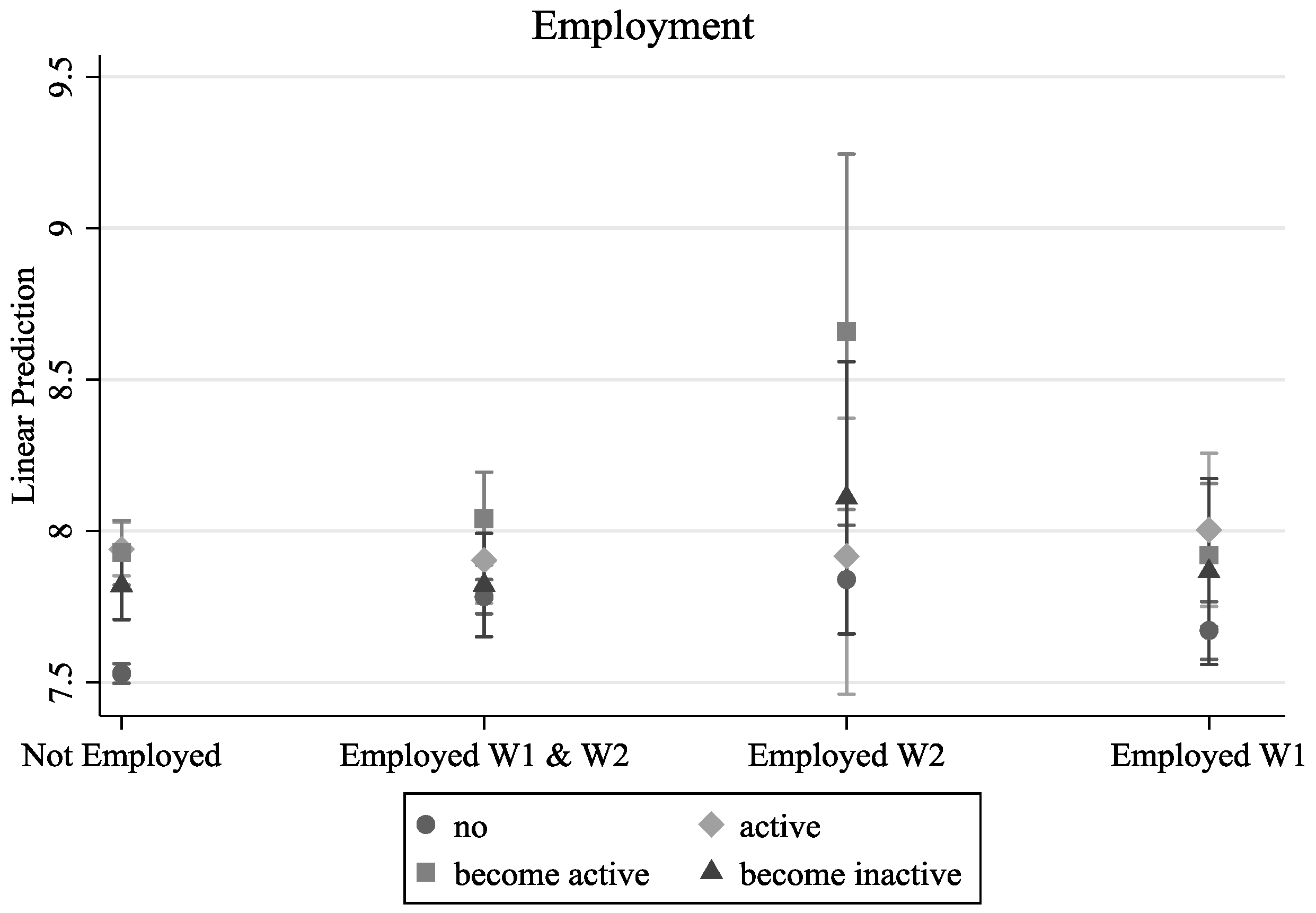
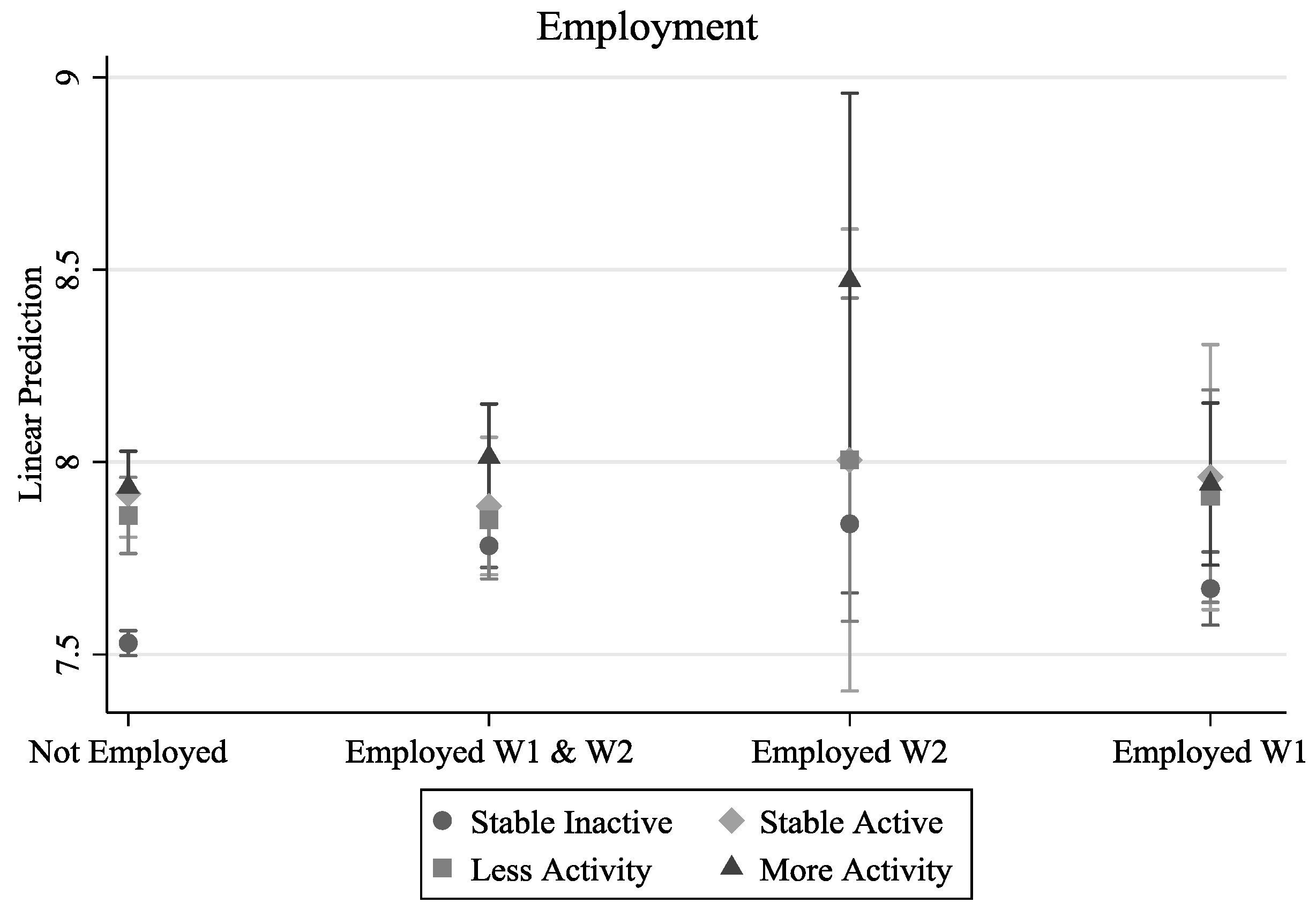
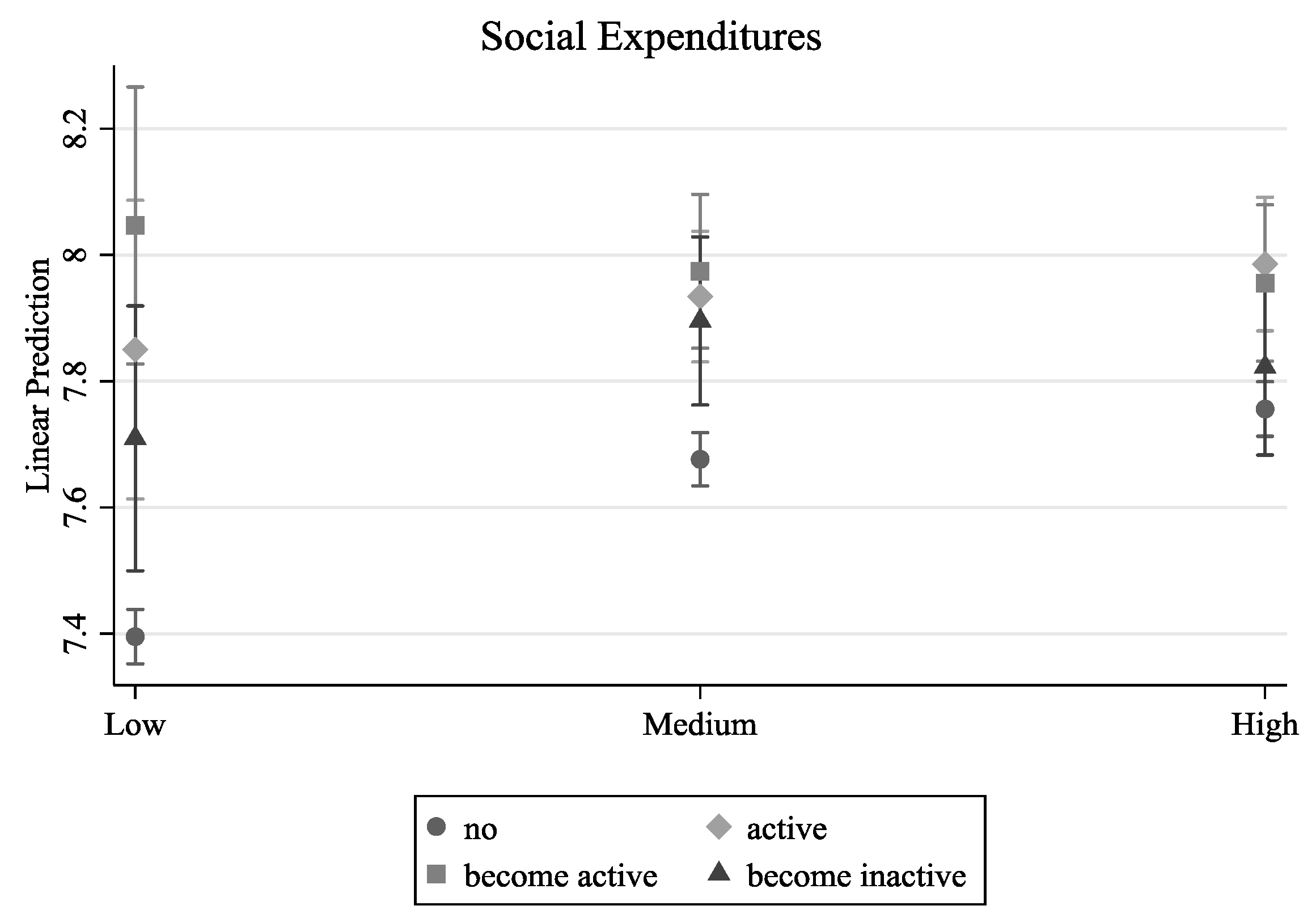
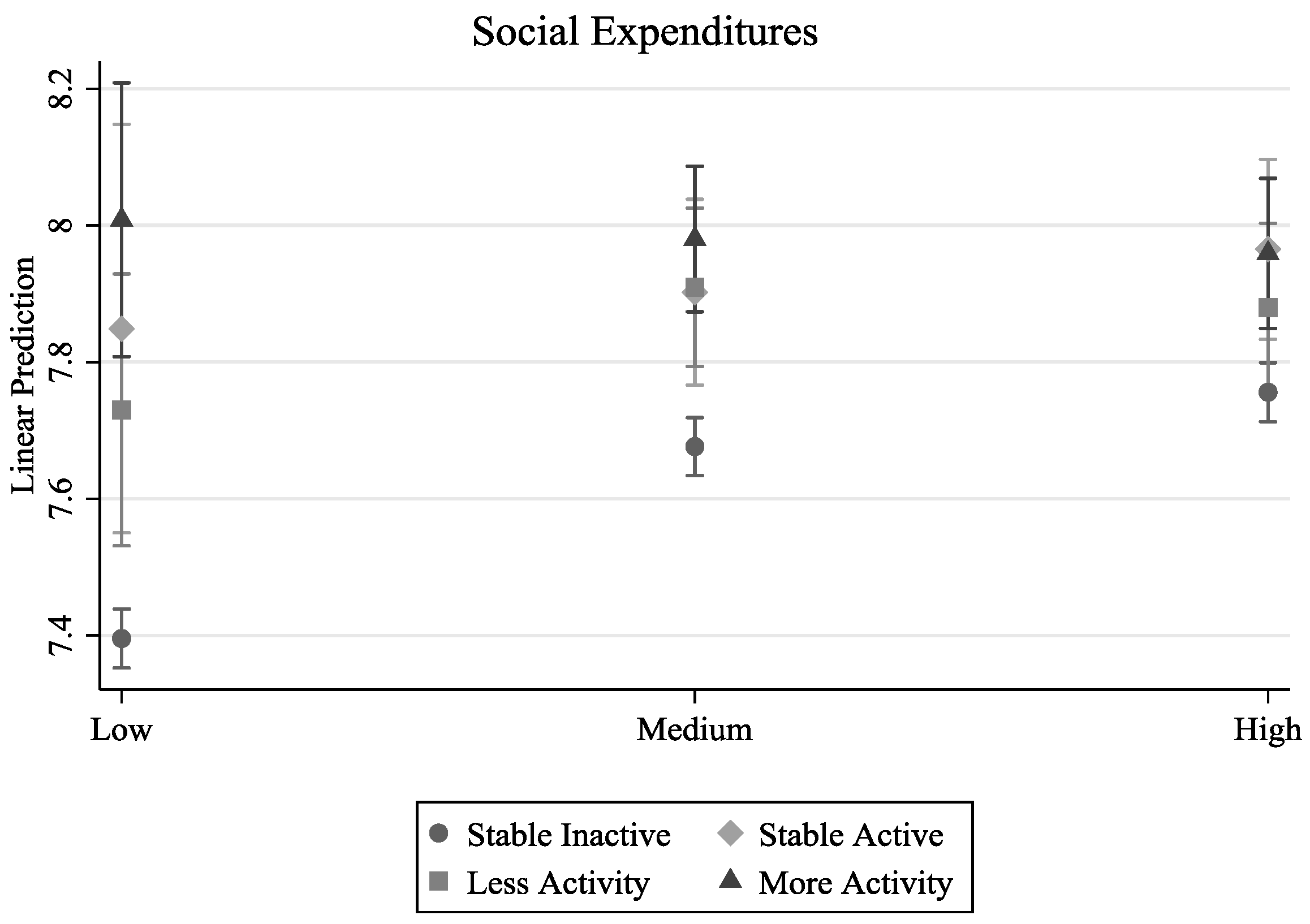
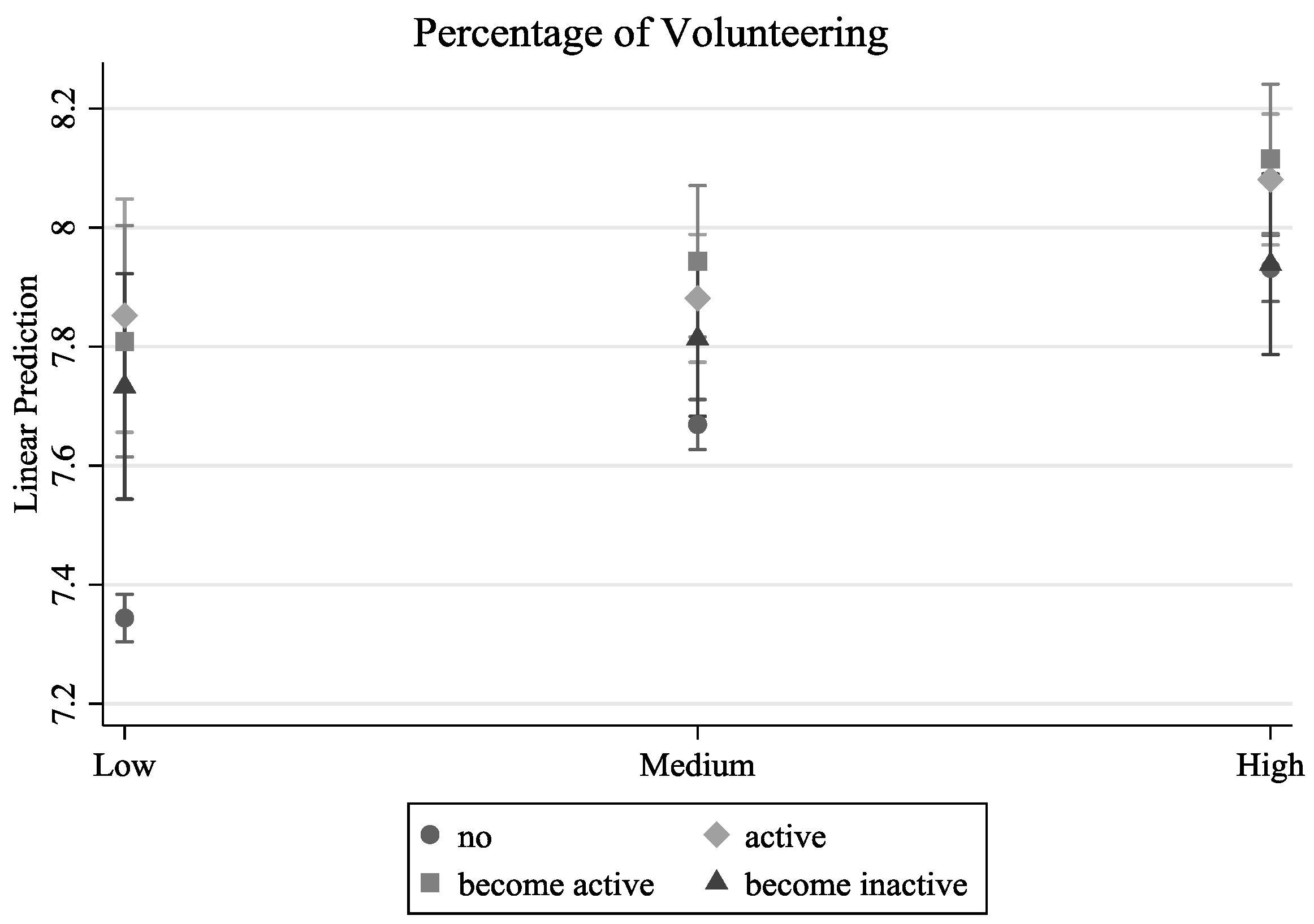
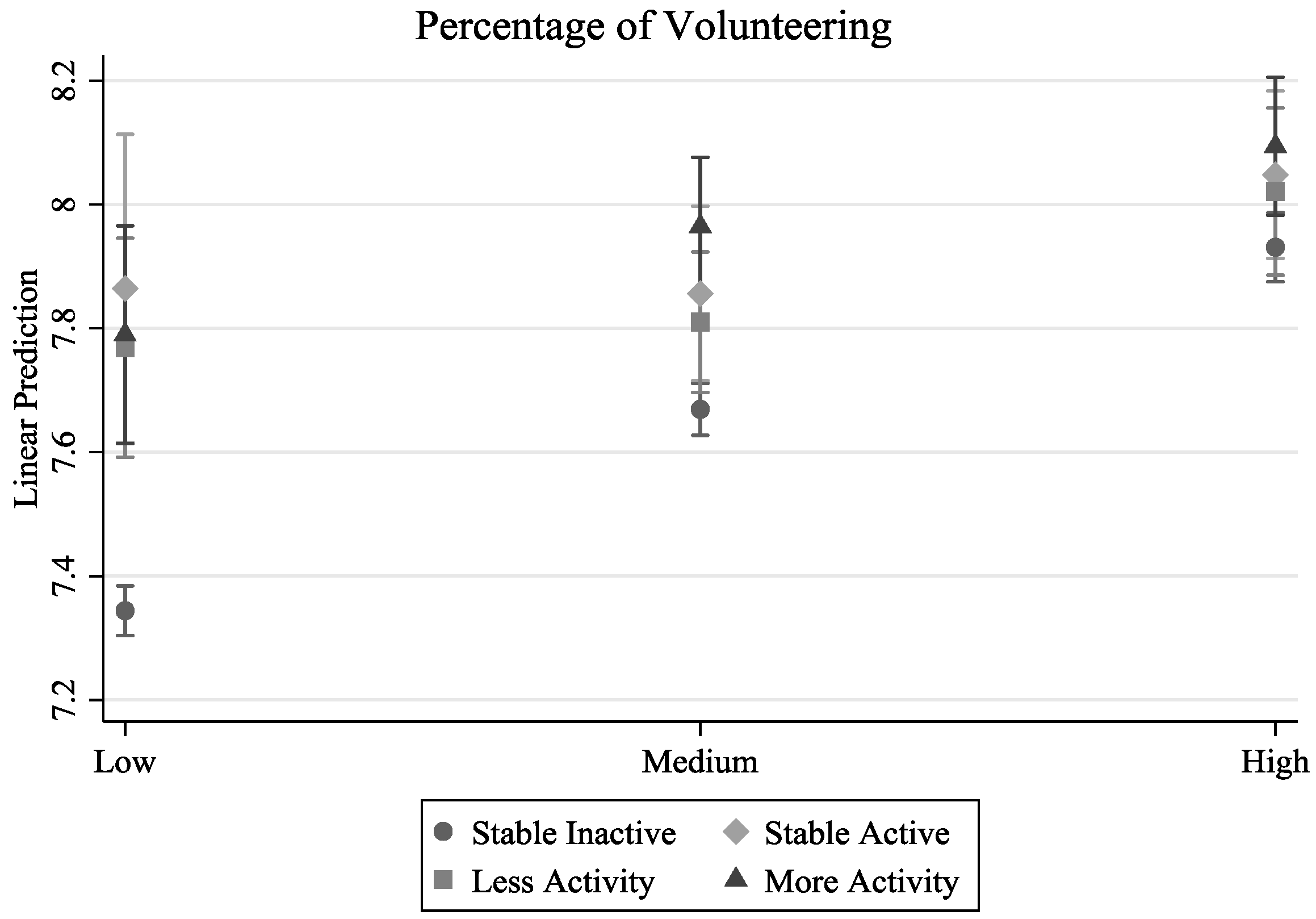
| Social Spending | Classification | Rate of Volunteering | Classification | |
|---|---|---|---|---|
| Norway | 12,889.9 | High | 38.81 | High |
| Sweden | 10,968.3 | Medium | 30.41 | Medium |
| Denmark | 12,109.2 | High | 37.03 | High |
| Netherlands | 9891.0 | Medium | 46.85 | High |
| Belgium | 11,123.6 | High | 34.00 | Medium |
| Germany | 10,466.5 | Medium | 23.76 | Low |
| Austria | 11,555.9 | High | 26.49 | Medium |
| Switzerland | 9428.5 | Low | 36.56 | High |
| France | 11,014.9 | Medium | 25.98 | Medium |
| Spain | 8367.4 | Low | 12.87 | Low |
| Italy | 9502.7 | Low | 23.04 | Low |
| Greece | 6905.2 | Low | 15.53 | Low |
| W1 | W2 | W1 to W2 | |||||||||||||
|---|---|---|---|---|---|---|---|---|---|---|---|---|---|---|---|
| Active (≥Monthly) Volunteering | Intensity of Volunteering b | ||||||||||||||
| Country (N) | Not a | Monthly | Weekly | Daily | Not a | Monthly | Weekly | Daily | Inactive in Both Waves | Active Both Waves | Inactive → Active | Active → Inactive | Stable Level c | Less d | More e |
| Norway (1606) | 74.2 | 15.6 | 8.9 | 1.4 | 68.4 | 16.7 | 13.3 | 1.6 | 61.2 | 18.4 | 13.1 | 7.4 | 12.5 | 9.3 | 17.1 |
| Sweden (1927) | 80.7 | 8.2 | 8.4 | 2.8 | 77.7 | 8.9 | 10.0 | 3.5 | 70.7 | 12.3 | 10.0 | 7.0 | 6.4 | 9.4 | 13.5 |
| Denmark (1091) | 80.3 | 7.8 | 10.1 | 1.8 | 76.4 | 8.8 | 11.5 | 3.4 | 68.8 | 12.2 | 11.5 | 7.5 | 7.1 | 9.4 | 14.7 |
| Netherlands (1587) | 76.1 | 5.6 | 14.5 | 3.8 | 73.9 | 5.7 | 16.3 | 4.0 | 66.5 | 16.5 | 9.6 | 7.4 | 10.8 | 9.8 | 12.9 |
| Belgium (2559) | 82.1 | 5.9 | 8.5 | 3.5 | 82.4 | 5.8 | 8.5 | 3.3 | 76.1 | 11.7 | 6.0 | 6.3 | 7.3 | 8.6 | 8.0 |
| Germany (1467) | 86.1 | 5.2 | 6.2 | 2.5 | 84.9 | 4.8 | 8.1 | 2.2 | 78.8 | 7.8 | 7.3 | 6.1 | 4.4 | 7.6 | 9.1 |
| Austria (1051) | 90.0 | 4.8 | 4.9 | 0.4 | 90.4 | 4.8 | 4.2 | 0.7 | 84.0 | 3.6 | 6.0 | 6.4 | 2.2 | 7.2 | 6.6 |
| Switzerland (642) | 84.9 | 6.4 | 6.9 | 1.9 | 82.9 | 6.4 | 8.3 | 2.5 | 75.2 | 7.5 | 9.7 | 7.6 | 3.9 | 9.2 | 11.7 |
| France (1652) | 82.6 | 5.2 | 7.9 | 4.3 | 83.8 | 5.2 | 7.4 | 3.6 | 76.3 | 9.9 | 6.3 | 7.5 | 5.2 | 10.4 | 8.1 |
| Spain (1278) | 97.1 | 1.7 | 0.6 | 0.6 | 97.1 | 0.9 | 1.3 | 0.7 | 95.4 | 1.2 | 1.7 | 1.7 | 0.6 | 1.8 | 2.2 |
| Italy (1597) | 92.1 | 2.8 | 3.8 | 1.4 | 92.0 | 2.8 | 3.4 | 1.9 | 87.7 | 3.6 | 4.4 | 4.3 | 2.3 | 4.8 | 5.3 |
| Greece (2103) | 96.5 | 1.7 | 1.4 | 0.5 | 98.0 | 1.1 | 0.8 | 0.1 | 95.7 | 1.2 | 0.8 | 2.3 | 1.1 | 2.4 | 0.9 |
| Pooled (18,560) | 85.1 | 5.9 | 6.9 | 2.2 | 84.0 | 5.9 | 7.7 | 2.3 | 78.2 | 9.1 | 6.9 | 5.8 | 5.5 | 7.4 | 8.9 |
| Volunteer Status | + Individual-Level Factors | + Country Social Spending | + Country Rate of Volunteering | |
|---|---|---|---|---|
| Volunteer status (VS) (ref: inactive in both waves) | ||||
| Active in both waves | 0.61 ** | 0.32 ** | 0.27 ** | 0.24 ** |
| Active at w2 (starting) | 0.64 ** | 0.35 ** | 0.31 ** | 0.28 ** |
| Active at w1 (quitting) | 0.43 ** | 0.22 ** | 0.18 ** | 0.16 ** |
| Male | −0.14 ** | −0.14 ** | −0.15 ** | |
| Age | 0.01 ** | 0.01 ** | 0.01 ** | |
| High education | 0.01 | −0.01 | −0.01 | |
| Financial situation (ref: great difficulty) | ||||
| Difficult | 0.54 ** | 0.49 ** | 0.49 ** | |
| Easy | 1.01 ** | 0.90 ** | 0.87 ** | |
| Very easy | 1.42 ** | 1.27 ** | 1.20 ** | |
| Change in subjective health | 0.07 ** | 0.07 ** | 0.07 ** | |
| Functional health (ref: no health limitations) | ||||
| Limitation in both waves | −0.26 ** | −0.29 ** | −0.28 ** | |
| Limitations in wave 2 | −0.53 ** | −0.56 ** | −0.55 ** | |
| Limitations in wave 1 | 0.02 | 0.00 | −0.00 | |
| Partner status (ref: no partner both waves) | ||||
| Partner both waves | 0.33 ** | 0.35 ** | 0.36 ** | |
| Partner in wave 2 | 0.51 ** | 0.49 ** | 0.50 ** | |
| Partner in wave 1 | −0.24 ** | −0.24 ** | −0.24 ** | |
| Employment status (ref: not employed both waves) | ||||
| Employed both waves | 0.20 ** | 0.19 ** | 0.17 ** | |
| Employed in wave 2 | 0.30 ** | 0.29 ** | 0.28 ** | |
| Employed in wave 1 | 0.11 * | 0.09 * | 0.08 | |
| Time between waves | 0.01 ** | 0.01 ** | 0.00 | |
| Depressive symptoms (wave 1) | −0.36 ** | −0.37 ** | −0.37 ** | |
| Country social spending/rate of vol. (ref: low) | ||||
| Medium | 0.26 ** | 0.29 ** | ||
| High | 0.32 ** | 0.53 ** | ||
| VS interactions | ||||
| VS × Age group | 4.45 ** | |||
| VS × Employment status | 2.24 * | |||
| VS × Social spending | 2.89 ** | |||
| VS × Rate of volunteering | 3.77 ** | |||
| R2 | 0.02 | 0.23 | 0.23 | 0.24 |
| Volunteering Intensity | + Individual-Level Factors | + Country Social Spending | + Country Rate of Volunteering | |
|---|---|---|---|---|
| Volunteering intensity (VI) (ref: stable inactive) | ||||
| Stable intensity | 0.57 ** | 0.30 ** | 0.25 ** | 0.21 ** |
| Decreasing activity | 0.46 ** | 0.25 ** | 0.21 ** | 0.19 ** |
| Increasing activity | 0.66 ** | 0.35 ** | 0.31 ** | 0.27 ** |
| VI interactions | ||||
| VI × Age group | 3.96 ** | |||
| VI × Employment status | 1.95 * | |||
| VI × Social spending | 2.63 ** | |||
| VI × Rate of volunteering | 3.53 ** | |||
| R2 | 0.02 | 0.23 | 0.23 | 0.24 |
© 2018 by the authors. Licensee MDPI, Basel, Switzerland. This article is an open access article distributed under the terms and conditions of the Creative Commons Attribution (CC BY) license (http://creativecommons.org/licenses/by/4.0/).
Share and Cite
Hansen, T.; Aartsen, M.; Slagsvold, B.; Deindl, C. Dynamics of Volunteering and Life Satisfaction in Midlife and Old Age: Findings from 12 European Countries. Soc. Sci. 2018, 7, 78. https://doi.org/10.3390/socsci7050078
Hansen T, Aartsen M, Slagsvold B, Deindl C. Dynamics of Volunteering and Life Satisfaction in Midlife and Old Age: Findings from 12 European Countries. Social Sciences. 2018; 7(5):78. https://doi.org/10.3390/socsci7050078
Chicago/Turabian StyleHansen, Thomas, Marja Aartsen, Britt Slagsvold, and Christian Deindl. 2018. "Dynamics of Volunteering and Life Satisfaction in Midlife and Old Age: Findings from 12 European Countries" Social Sciences 7, no. 5: 78. https://doi.org/10.3390/socsci7050078
APA StyleHansen, T., Aartsen, M., Slagsvold, B., & Deindl, C. (2018). Dynamics of Volunteering and Life Satisfaction in Midlife and Old Age: Findings from 12 European Countries. Social Sciences, 7(5), 78. https://doi.org/10.3390/socsci7050078





